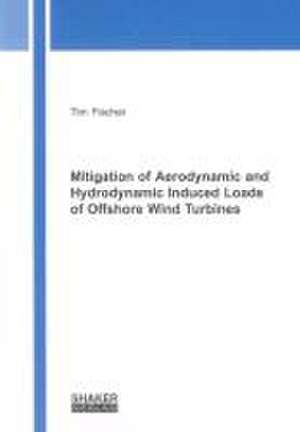Mitigation of Aerodynamic and Hydrodynamic Induced Loads of Offshore Wind Turbines: Berichte aus der Luft- und Raumfahrttechnik
Autor Tim Fischeren Limba Engleză Paperback – 13 dec 2012
Din seria Berichte aus der Luft- und Raumfahrttechnik
-
 Preț: 86.74 lei
Preț: 86.74 lei -
 Preț: 245.36 lei
Preț: 245.36 lei -
 Preț: 261.74 lei
Preț: 261.74 lei -
 Preț: 261.44 lei
Preț: 261.44 lei -
 Preț: 261.96 lei
Preț: 261.96 lei -
 Preț: 264.86 lei
Preț: 264.86 lei -
 Preț: 260.95 lei
Preț: 260.95 lei -
 Preț: 261.61 lei
Preț: 261.61 lei -
 Preț: 245.00 lei
Preț: 245.00 lei -
 Preț: 244.34 lei
Preț: 244.34 lei -
 Preț: 318.19 lei
Preț: 318.19 lei -
 Preț: 244.56 lei
Preț: 244.56 lei -
 Preț: 260.13 lei
Preț: 260.13 lei -
 Preț: 259.72 lei
Preț: 259.72 lei -
 Preț: 270.94 lei
Preț: 270.94 lei -
 Preț: 280.09 lei
Preț: 280.09 lei -
 Preț: 277.99 lei
Preț: 277.99 lei -
 Preț: 316.18 lei
Preț: 316.18 lei -
 Preț: 260.07 lei
Preț: 260.07 lei -
 Preț: 271.16 lei
Preț: 271.16 lei -
 Preț: 280.63 lei
Preț: 280.63 lei -
 Preț: 260.95 lei
Preț: 260.95 lei -
 Preț: 279.32 lei
Preț: 279.32 lei -
 Preț: 272.70 lei
Preț: 272.70 lei -
 Preț: 206.25 lei
Preț: 206.25 lei -
 Preț: 244.78 lei
Preț: 244.78 lei -
 Preț: 246.00 lei
Preț: 246.00 lei -
 Preț: 263.85 lei
Preț: 263.85 lei -
 Preț: 260.36 lei
Preț: 260.36 lei -
 Preț: 245.22 lei
Preț: 245.22 lei -
 Preț: 262.40 lei
Preț: 262.40 lei -
 Preț: 245.43 lei
Preț: 245.43 lei -
 Preț: 279.24 lei
Preț: 279.24 lei -
 Preț: 243.61 lei
Preț: 243.61 lei -
 Preț: 272.03 lei
Preț: 272.03 lei -
 Preț: 263.78 lei
Preț: 263.78 lei -
 Preț: 280.48 lei
Preț: 280.48 lei -
 Preț: 243.83 lei
Preț: 243.83 lei -
 Preț: 275.75 lei
Preț: 275.75 lei -
 Preț: 264.95 lei
Preț: 264.95 lei -
 Preț: 299.27 lei
Preț: 299.27 lei -
 Preț: 261.45 lei
Preț: 261.45 lei -
 Preț: 272.19 lei
Preț: 272.19 lei -
 Preț: 260.95 lei
Preț: 260.95 lei -
 Preț: 279.08 lei
Preț: 279.08 lei -
 Preț: 259.81 lei
Preț: 259.81 lei -
 Preț: 262.84 lei
Preț: 262.84 lei -
 Preț: 263.28 lei
Preț: 263.28 lei -
 Preț: 278.31 lei
Preț: 278.31 lei
Preț: 290.28 lei
Nou
Puncte Express: 435
Preț estimativ în valută:
55.54€ • 57.99$ • 45.97£
55.54€ • 57.99$ • 45.97£
Carte indisponibilă temporar
Doresc să fiu notificat când acest titlu va fi disponibil:
Se trimite...
Preluare comenzi: 021 569.72.76
Specificații
ISBN-13: 9783844015010
ISBN-10: 3844015019
Pagini: 227
Dimensiuni: 146 x 208 x 17 mm
Greutate: 0.32 kg
Editura: Shaker Verlag
Seria Berichte aus der Luft- und Raumfahrttechnik
ISBN-10: 3844015019
Pagini: 227
Dimensiuni: 146 x 208 x 17 mm
Greutate: 0.32 kg
Editura: Shaker Verlag
Seria Berichte aus der Luft- und Raumfahrttechnik
